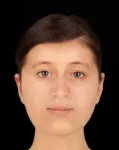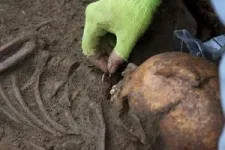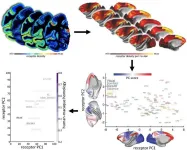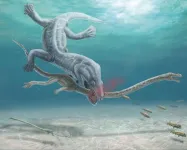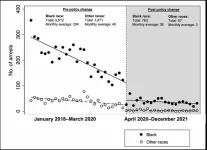(Press-News.org)
The face of a 16-year-old woman buried near Cambridge (UK) in the 7th century with an incredibly rare gold and garnet cross (the ‘Trumpington Cross’) has been reconstructed following analysis of her skull. The striking image is going on public display for the first time on 21st June, with new scientific evidence showing that she moved to England from Central Europe as a young girl, leading to an intriguing change in her diet.
The image and artefacts from the mysterious woman’s burial – discovered in 2012 by the Cambridge Archaeological Unit at Trumpington Meadows on Cambridge’s southern limits – including her famous cross will be unveiled in a major new exhibition at Cambridge’s Museum of Archaeology and Anthropology (MAA). ‘Beneath Our Feet: Archaeology of the Cambridge Region’ will run from 21st June to 14th April 2024.
Forensic artist Hew Morrison created the likeness using measurements of the woman’s skull and tissue depth data for Caucasian females. Without DNA analysis, Morrison could not be sure of her precise eye and hair colour, but the image offers a strong indication of her appearance shortly before she died.
Hew Morrison said: “It was interesting to see her face developing. Her left eye was slightly lower, about half a centimetre, than her right eye. This would have been quite noticeable in life.”
New “you are what you eat” isotopic analysis of the young woman’s bones and teeth conducted by bioarchaeologists Dr Sam Leggett and Dr Alice Rose, and archaeologist Dr Emma Brownlee, during PhD research at the University of Cambridge also reveals that she moved to England from somewhere near the Alps, perhaps southern Germany, sometime after she turned 7 years old.
Leggett and Rose also found that once the girl had arrived in England, the proportion of protein in her diet decreased by a small but significant amount. This change occurred close to the end of her young life, showing that the period between her migration and burial near Cambridge was tragically short.
Dr Leggett, now at the University of Edinburgh, said: “She was quite a young girl when she moved, likely from part of southern Germany, close to the Alps, to a very flat part of England. She was probably quite unwell and she travelled a long way to somewhere completely unfamiliar – even the food was different. It must have been scary.”
Previous analysis indicated that the young woman had suffered from illness but her cause of death remains unknown. She was buried in a remarkable way – lying on a carved wooden bed wearing the cross, gold pins (also on display) and fine clothing.
Hers is one of only 18 bed burials ever uncovered in the UK. Her ornate cross, combining gold and garnets (third quarter of the 7th century), is one of only five of its kind ever found in Britain and identifies her as one of England’s earliest converts to Christianity and as a member of the aristocracy if not royalty. The best known example of such a cross was found in the coffin of St Cuthbert.
In 597 AD, the pope dispatched St Augustine to England on a mission to convert the pagan Anglo-Saxon kings, a process which continued for many decades.
Dr Leggett said: “She must have known that she was important and she had to carry that on her shoulders. Her isotopic results match those of two other women who were similarly buried on beds in this period in Cambridgeshire.
“So it seems that she was part of an elite group of women who probably travelled from mainland Europe, most likely Germany, in the 7th century, but they remain a bit of a mystery. Were they political brides or perhaps brides of Christ? The fact that her diet changed once she arrived in England suggests that her lifestyle may have changed quite significantly.”
Dr Sam Lucy, a specialist in Anglo-Saxon burial from Newnham College, Cambridge, who published the Anglo-Saxon excavations at Trumpington*, said:
“These are intriguing findings, and it is wonderful to see this collaborative research adding to our knowledge of this period. Combining the new isotopic results with Emma Brownlee’s research into European bed burials really does seem to suggest the movement of a small group of young elite women from a mountainous area in continental Europe to the Cambridge region in the third quarter of the seventh century.
“Southern Germany is a distinct possibility owing to the bed burial tradition known there. Given the increasingly certain association between bed burial, such cross-shaped jewellery, and early Anglo-Saxon Christianity, it is possible that their movement related to pan-European networks of elite women who were heavily involved in the early Church.”
Dr Jody Joy, the exhibition’s co-curator, said: “The story of this young woman goes to the very heart of what our exhibition is all about – new research making visible the lives of people at pivotal moments of Cambridgeshire’s history. MAA holds one of Britain’s most important collections of Early Medieval archaeology and the Trumpington bed burial is so important. It looks like it still has much more to teach us.”
In the exhibition, the ‘Trumpington Cross’ will be displayed together with the delicate gold and garnet pins connected by a gold chain, which were found near the teenager’s neck. These pins probably secured a long veil to an outer garment of fine linen. The pins would have caught the light as she moved. The burial bed’s decorative headboard will also be exhibited.
Beneath Our Feet exhibition – other highlights
MAA’s exhibition explores the traces of where people have lived, worked and died for thousands of years in Cambridgeshire. It unveils a wide range of treasures never and rarely seen by the public including:
Pottery and textile finds from Must Farm “Britain’s Pompeii”;
An ornate armlet and pottery belonging to a feast-loving chieftain who died shortly before the Roman invasion;
A carving of an Iron Age man with a distinctive hairstyle and moustache, made soon after the invasion;
Finds from a cemetery at Girton College now known, thanks to the work of Dr Emma Brownlee, to have been in continuous use from Roman to Early Medieval times;
A young friar’s elephant ivory belt buckle recently found in the cemetery of Cambridge’s Augustinian Friary.
‘Beneath Our Feet’ is a free exhibition at the University of Cambridge’s Museum of Archaeology and Anthropology (21st June 2023 – 14th April 2024). More info here.
Media contacts
Tom Almeroth-Williams, Communications Manager (Research), University of Cambridge: researchcommunications@admin.cam.ac.uk / tel: +44 (0) 7540 139 444
Notes to editors
* C. Evans, S. Lucy & R. Patten, Riversides: Neolithic Barrows, a Beaker Grave, Iron Age and Anglo-Saxon Burials and Settlement at Trumpington, Cambridge (2018); and S. Lucy, ‘The Trumpington Cross in context’, Anglo-Saxon England (2016).
END
Face of Anglo-Saxon teen VIP revealed with new evidence about her life
2023-06-20
ELSE PRESS RELEASES FROM THIS DATE:
Weak policies and political ideologies risk jeopardizing plans to tackle health and climate change, says Cambridge expert
2023-06-20
Weak policies and political ideologies risk jeopardising plans to tackle health and climate change, says Cambridge expert
Efforts to tackle major issues facing the UK, including the nation’s health and climate change, are being hampered because politicians often ignore the existing evidence when setting policies, according to Dame Theresa Marteau, a public health expert at the University of Cambridge.
Writing in the journal Science and Public Policy, Professor Marteau argues that this ‘evidence-neglect’ is a result of incentive structures that encourage politicians to set ambitious policy goals while simultaneously disincentivising ...
Low-dose aspirin use associated with 20% increased anemia risk in older adults
2023-06-19
1. Low-dose aspirin use associated with 20% increased anemia risk in older adults
Abstract: https://www.acpjournals.org/doi/10.7326/M23-0675
URL goes live when the embargo lifts
An analysis of the ASPREE (ASPirin in Reducing Events in the Elderly) trial found that the use of low-dose aspirin was associated with a 20 percent increased incidence of anemia and decline in ferritin, or blood iron levels, in otherwise healthy older adults. These findings suggest that periodic monitoring of hemoglobin should be considered in older patients taking aspirin. The analysis is published in Annals ...
Chinese paleogeneticist FU Qiaomei awarded UNESCO–AI Fozan International Prize for the Promotion of Young Scientists
2023-06-19
FU Qiaomei, a paleogeneticist at the Chinese Academy of Sciences (CAS), received the UNESCO–AI Fozan International Prize for the Promotion of Young Scientists in Science, Technology, Engineering and Mathematics (STEM) on June 19 in Paris, France, for her “seminal work on the history of early humans in Eurasia, based on genetic lineage studies, which provides new insights on the early human history of Eurasia and perspectives on the evolution of human health.”
She was one of five young scientists from around the world to receive the prize, alongside researchers from Argentina, Cameroon, Egypt, and Serbia. The laureates were ...
Clean, sustainable fuels made ‘from thin air’ and plastic waste
2023-06-19
Researchers have demonstrated how carbon dioxide can be captured from industrial processes – or even directly from the air – and transformed into clean, sustainable fuels using just the energy from the Sun.
The researchers, from the University of Cambridge, developed a solar-powered reactor that converts captured CO2 and plastic waste into sustainable fuels and other valuable chemical products. In tests, CO2 was converted into syngas, a key building block for sustainable liquid fuels, and plastic bottles were converted into glycolic acid, which is widely used in the cosmetics industry.
Unlike earlier tests ...
Human Brain Project study offers insights into neuroreceptor organization
2023-06-19
A key challenge in neuroscience is to understand how the brain can adapt to a changing world, even with a relatively static anatomy. The way the brain’s areas are structurally and functionally related to each other – its connectivity – is a key component. In order to explain its dynamics and functions, we also need to add another piece to the puzzle: receptors. Now, a new mapping by Human Brain Project (HBP) researchers from the Forschungszentrum Jülich (Germany) and Heinrich-Heine-University Düsseldorf (Germany), in collaboration with scientists from the University of Bristol (UK), ...
These long-necked reptiles were decapitated by their predators, fossil evidence confirms
2023-06-19
In the age of dinosaurs, many marine reptiles had extremely long necks compared to reptiles today. While it was clearly a successful evolutionary strategy, paleontologists have long suspected that their long-necked bodies made them vulnerable to predators. Now, after almost 200 years of continued research, direct fossil evidence confirms this scenario for the first time in the most graphic way imaginable.
Researchers reporting in the journal Current Biology on June 19 studied the unusual necks of two Triassic ...
Brain receptor patterns separate sensory and cognitive networks, new study finds
2023-06-19
Receptor patterns define key organisational principles in the brain, scientists have discovered.
An international team of researchers, studying macaque brains, have mapped out neurotransmitter receptors, revealing a potential role in distinguishing internal thoughts and emotions from those generated by external influences.
The comprehensive dataset has been made publicly available, serving as a bridge linking different scales of neuroscience - from the microscopic to the whole brain.
Lead author Sean Froudist-Walsh, ...
A new tool to study complex genome interactions
2023-06-19
People who owned black-and-white television sets until the 1980s didn’t know what they were missing until they got a color TV. A similar switch could happen in the world of genomics as researchers at the Berlin Institute of Medical Systems Biology of the Max Delbrück Center (MDC-BIMSB) have developed a technique called Genome Architecture Mapping (“GAM”) to peer into the genome and see it in glorious technicolor. GAM reveals information about the genome’s spatial architecture that is invisible to scientists using solely Hi-C, a workhorse tool developed in 2009 to study DNA interactions, reports a new study in Nature Methods by the Pombo lab.
“With ...
Assessment of how climate scientists communicate risk shows imperfections, improvements
2023-06-19
Scientists have long struggled to find the best way to present crucial facts about future sea level rise, but are getting better at communicating more clearly, according to an international group of climate scientists, including a leading Rutgers expert.
The consequences of improving communications are enormous, the scientists said, as civic leaders actively incorporate climate scientists’ risk assessments into major planning efforts to counter some of the effects of rising seas.
Writing in Nature Climate Change, the scientists ...
De facto decriminalization of drug possession reduces the overall arrest toll on the Black community, although racial disparities persist
2023-06-19
Ann Arbor, June 19, 2023 – De facto decriminalization of drug possession may be a good first step in addressing the disproportionate impact of an overburdened United States criminal justice system on the Black community. According to a new study in the American Journal of Preventive Medicine, published by Elsevier, this strategy was associated with significant and sustained reductions in low-level arrests. These arrests too often prevent drug users from obtaining needed treatments and services. The findings also suggest that while these policies may effectively reduce the overall arrest toll, striking disparities persist in how police are applying the directives across racial ...
